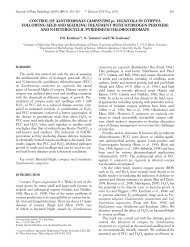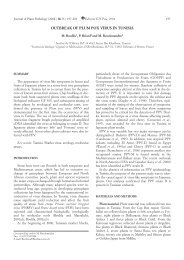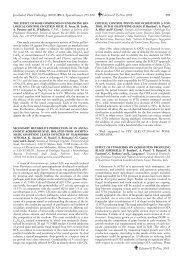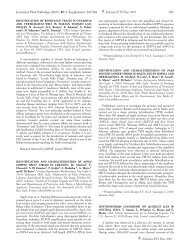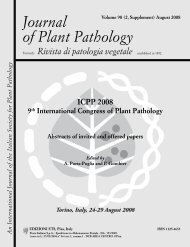Journal of Plant Pathology (2010), 92 (4, Supplement ... - Sipav.org
Journal of Plant Pathology (2010), 92 (4, Supplement ... - Sipav.org
Journal of Plant Pathology (2010), 92 (4, Supplement ... - Sipav.org
You also want an ePaper? Increase the reach of your titles
YUMPU automatically turns print PDFs into web optimized ePapers that Google loves.
<strong>Journal</strong> <strong>of</strong> <strong>Plant</strong> <strong>Pathology</strong> (<strong>2010</strong>), <strong>92</strong> (4, <strong>Supplement</strong>), S4.71-S4.105 S4.79<br />
ANTIFUNGAL ACTIVITY OF ALCOHOLIC EXTRACT<br />
FROM SPARTIUM JUNCEUM : PRELIMINARY SCREEN-<br />
ING STUDIES. F. Clematis, C. Pasini, P. Curir. CRA, Unità di<br />
Ricerca per la Floricoltura e le Specie Ornamentali (CRA-FSO),<br />
Corso Inglesi 08, 18038 Sanremo (IM), Italy. E-mail: f.clematis@<br />
istflori.it<br />
The antifungal properties <strong>of</strong> Spartium junceum, a perennial<br />
shrubs native to the Mediterranean area and widespread throughout<br />
Italy, were tested against eight selected fungal pathogens.<br />
<strong>Plant</strong> material (stem and leaves) were extracted with ethanol (1:1)<br />
in a soxhlet apparatus under refluxing conditions for 3 h. The efficacy<br />
<strong>of</strong> plant extracts was tested in vitro by poisoned food technique<br />
at different concentrations (2, 1.6, and 1%). The best inhibition<br />
values ranged between 21.3 and 46%. The highest concentration<br />
<strong>of</strong> plant extract (2%) showed significant reduction on the<br />
growth <strong>of</strong> Fusarium oxysporum isolated from Danae racemosa and<br />
F. oxysporum f. sp. dianthi, while the lowest concentration (1%)<br />
was already effective in suppressing Alternaria dianthi and Botrytis<br />
cinerea. A. dianthi was inhibited by 46.0% when 2% <strong>of</strong> plant<br />
extract was applied, B. cinerea and both F. oxysporum strains<br />
were inhibited by 45.3 and 37.3%, respectively. This preliminary<br />
screening showed significant inhibition activity <strong>of</strong> S. junceum extracts<br />
already at low concentrations. Preliminary TLC and spectrophotometer<br />
analysis showed the presence <strong>of</strong> phenolic compounds<br />
in the extracts using UV absorbance at 275 nm. Investigations<br />
are in progress to study the phytochemical characteristics<br />
<strong>of</strong> plant extract by HPLC and TLC.<br />
AN APPROACH TO GRAPEVINE SANITARY SELEC-<br />
TION IN SARDINIA: FIELD STUDY AND SEROLOGICAL<br />
DIAGNOSIS. L. Cogotzi, V.A. Prota, R. Garau. Dipartimento di<br />
Protezione delle Piante, Sezione di Patologia Vegetale, Università<br />
degli Studi, Via Enrico De Nicola 1, 07100 Sassari, Italy. E-mail:<br />
lcogotzi@uniss.it<br />
Strategies to control viruses are essentially preventive and<br />
based on sanitary selection programs. Within this project, the creation<br />
<strong>of</strong> a germplasm collection will aim at progressive sanitary<br />
selection. Field studies, carried out over two years (2008-2009),<br />
focused on eleven local grapevine varieties: Vermentino, Cannonau,<br />
Monica, Bovale, Malvasia, Carignano, Nuragus, Nebbiolo,<br />
Moscato, Caricajola, and Nasco. Selected vineyards were inspected<br />
in spring, summer and autumn. Symptoms <strong>of</strong> virus and<br />
phytoplasma infections were common in these vineyards. Almost<br />
5000 essentially symptomless vines were selected in the course <strong>of</strong><br />
numerous field surveys carried out throughout the entire region<br />
and were tested serologically (ELISA). We focused on the presence<br />
<strong>of</strong> two types <strong>of</strong> viruses associated with leafroll disease<br />
(GLRaV-2, GLRaV-3) that cause severe losses, reduce yield and<br />
impact negatively fruit quality. Grapevine fanleaf virus (GFLV)<br />
and Grapevine virus A (GVA), an agent associated with Kober<br />
stem grooving were also looked for on a lower number <strong>of</strong> plants.<br />
Results showed that, in Sardinia, infection rates <strong>of</strong> GLRaV-2,<br />
GLRaV-3, GFLV and GVA range between 3 and 70%, 5 and<br />
80%, 0 and 40% and 5 and 60%, respectively. ‘Carignano’ from<br />
the Sulcis area (south-west Sardinia) had the highest percentage<br />
<strong>of</strong> virus-free plants while ‘Nuragus’ and ‘Malvasia, both from the<br />
south <strong>of</strong> Sardinia (Parteolla area) had the lowest. Selected plants<br />
will undergo further sanitary selection.<br />
Work funded by the Con.Vi.Sar. consortium <strong>of</strong> Sardinia<br />
PLANT VIRUSES AS POSSIBLE PLATFORMS FOR MOLE-<br />
CULAR FARMING. V. Condelli, A. Vitti, M. Nuzzaci, M.T.<br />
Lanorte, P. Piazzolla. Dipartimento di Biologia Difesa e Biotecnologie<br />
Agro-Forestali, Università degli Studi della Basilicata, Campus<br />
di Macchia Romana, Via dell’Ateneo Lucano 10, 85100 Potenza,<br />
Italy. E-mail: valentina.condelli@unibas.it<br />
<strong>Plant</strong> viruses are emerging as an attractive system for the expression<br />
<strong>of</strong> foreign epitopes used as immunogens for the development<br />
<strong>of</strong> innovative vaccination strategies. In such a way, plant<br />
viruses carrying on their coat protein (CP) peptides <strong>of</strong> medical<br />
interest can be considered, in association with their hosts, right<br />
partners <strong>of</strong> biological systems devoted to pursue the goal <strong>of</strong> functioning<br />
as medical molecular farming. Cucumber mosaic virus<br />
(CMV) is one <strong>of</strong> the plant viruses used as a carrier <strong>of</strong> foreign epitopes<br />
because <strong>of</strong> its wide host range, which comprises edible<br />
plants (celery, lettuce, cucumber, tomato, carrot, pepper, banana,<br />
ecc). The results <strong>of</strong> immunological experiments, obtained by using<br />
CMV as a presentation system for the Hepatitis C virus- and<br />
Alzheimer’s disease-derived epitopes, in association with the<br />
proven stability <strong>of</strong> CMV in gastrointestinal environment, seem to<br />
open a new prospect for the development <strong>of</strong> effective vaccine<br />
candidates. These data could be considered <strong>of</strong> paramount importance<br />
to health and medicine, thus suggesting to extend this strategy<br />
to other human and animal diseases, such as Influenza. Alternatively,<br />
another plant virus, Potato virus A (PVA) was selected as<br />
a carrier because the filamentous shape <strong>of</strong> its particles <strong>of</strong>fers no<br />
packaging limitation for rather large genome insertion. A molecular<br />
modeling approach has been used to identify the possible insertion<br />
points <strong>of</strong> foreign determinants, in order to get the best<br />
conditions <strong>of</strong> stability and infectivity <strong>of</strong> chimeric virus particles.<br />
MYCOTOXIGENIC FUSARIUM SPECIES AND MYCO-<br />
TOXINS IN WHEAT GRAIN IN 2008 IN UMBRIA. L. Covarelli,<br />
G. Beccari, M. Tinelli, G. Santoponte. Dipartimento di<br />
Scienze Agrarie e Ambientali, Università degli Studi, B<strong>org</strong>o XX<br />
Giugno 74, 06121 Perugia, Italy. E-mail: lorenzo.covarelli@<br />
unipg.it<br />
In 2008, a study was conducted on 53 durum wheat (DW)<br />
and 36 s<strong>of</strong>t wheat (SW) grain samples harvested in Umbria (central<br />
Italy). After visual observation <strong>of</strong> Fusarium damaged kernels,<br />
samples were subjected to fungal isolation on PDA, DNA extraction<br />
for Fusarium detection and identification by PCR, mycotoxin<br />
extraction for deoxynivalenol (DON) and T-2 toxin determination..<br />
DW and SW samples had 34% and 19% Fusarium-damaged<br />
kernels while average the incidence <strong>of</strong> Fusarium infections<br />
was 40% and 33%, respectively, in the two wheat species. PCR<br />
assays showed that the most frequent species were F. graminearum,<br />
F. avenaceum and F. culmorum. F. equiseti was also detected<br />
by PCR but was not isolated on PDA while F. poae was mainly<br />
detected by traditional isolation rather than by PCR. DON levels<br />
exceeded the EU legal limits in 9% <strong>of</strong> DW and 8% <strong>of</strong> SW samples,<br />
reaching contamination levels <strong>of</strong> 53 mg kg -1 in DW (average<br />
2 mg kg -1 ) and 10 mg kg -1 in SW (average 0.7 mg kg -1 ). T-2 toxin<br />
was constantly detected, with peaks <strong>of</strong> 187 µg kg -1 in DW (average<br />
62 µg kg -1 ) and 78 µg kg -1 in SW (average 40 µg kg -1 ). Our results<br />
indicate that, even if previous studies carried out in Umbria<br />
showed a low mycotoxins risk, in years like 2008 that was characterized<br />
by climatic conditions extremely favourable to Fusarium<br />
head blight, wheat contamination may represent an important<br />
problem also in the examined area.



